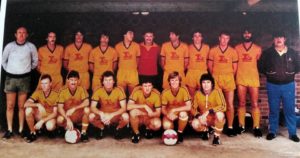The earliest known match of Association Football took place at Woogaroo Asylum, Goodna, in modern day Ipswich, on Saturday August 7 1875. The combatants were staff and patients of the Asylum, and the Brisbane Club.
Brisbane Club were the original football club in Queensland, which alternated between Rugby and Australian Rules during their existence. However for the sake of the “bedlam” players, rules adopted where the ball was not to be carried or handled.
The Footballer, a Victorian publication which reviewed the year’s football across the colonies, subsequently stated the match “was played without handling the ball under any circumstances whatever (Association rules)”. Though there had been earlier non-handling football matches in Australia, such as Hobart and Melbourne in 1870, contemporary newspaper reports do not provide enough details to definitively class these matches as soccer.
The Woogaroo match is currently considered the earliest match in Australia described as being played under British Association rules.
FQH wishes to thank Garry McKenzie for the above text.
